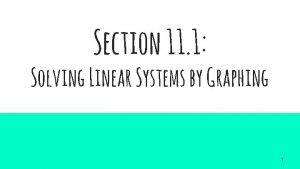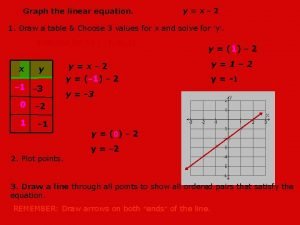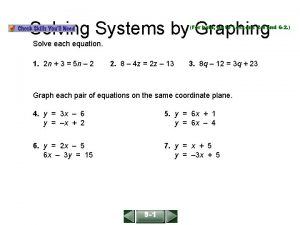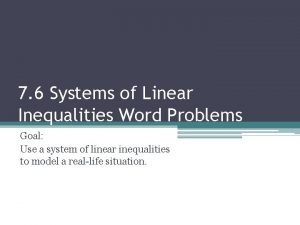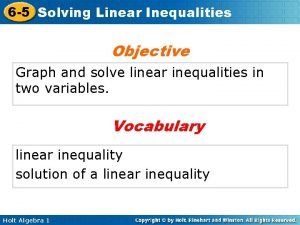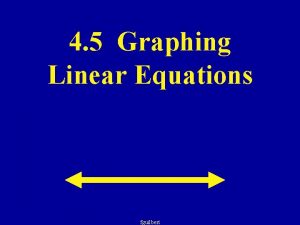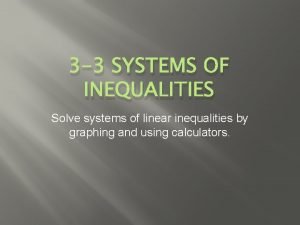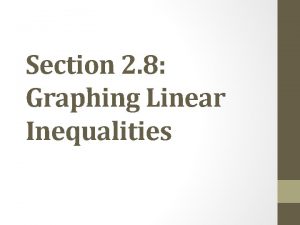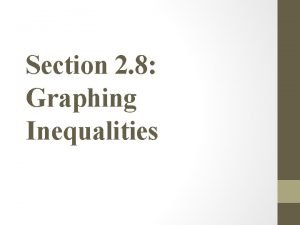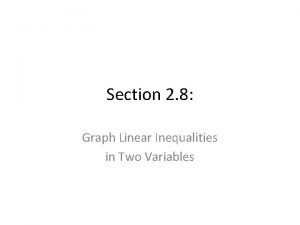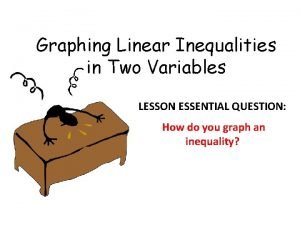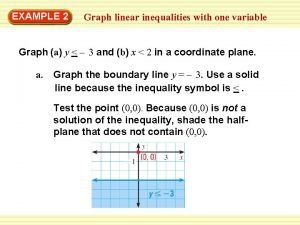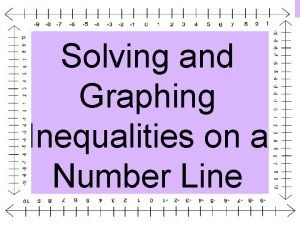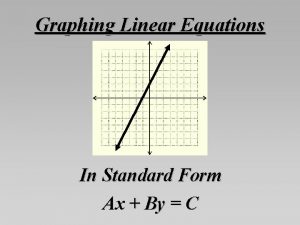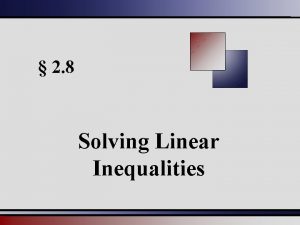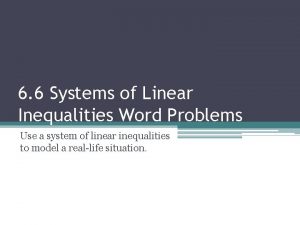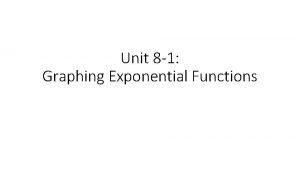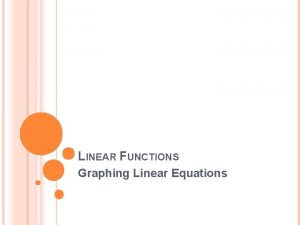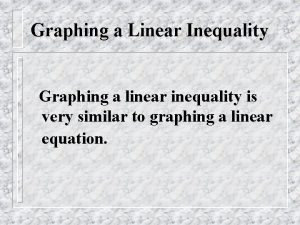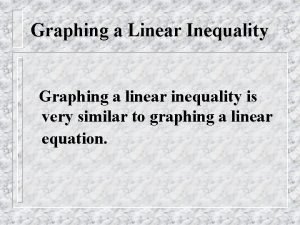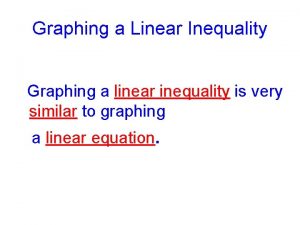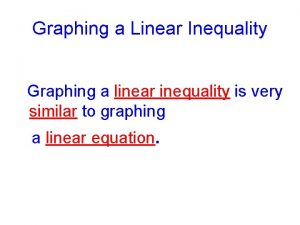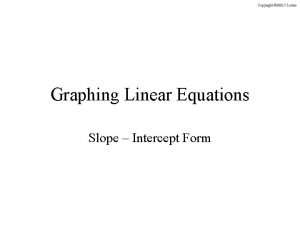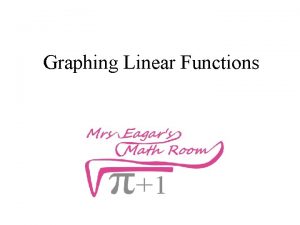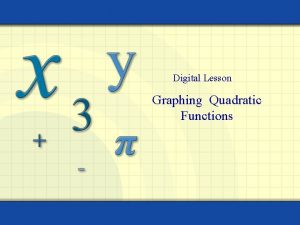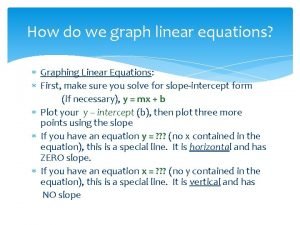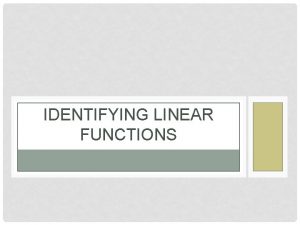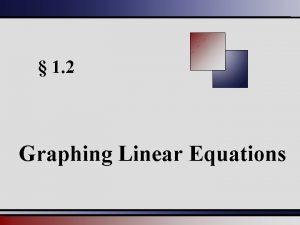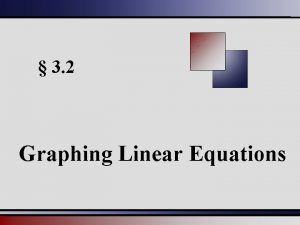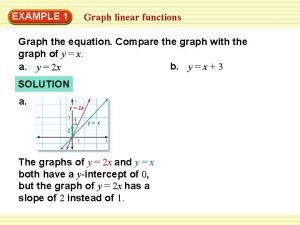Graphing Linear Functions 1 graph linear functions 2




























- Slides: 28

Graphing Linear Functions 1. graph linear functions. 2. write equations in standard form.

Warm Up, Do Now! • Solve for y 1. 3 – y = 10 2. 2 y + 4 = 8 3. 9 y + (-1) = 8 4. 0 – 5 = -10 y

Practice 1) Solve for y: 2) Solve for y: 3) Solve for y: 2 x + y = 4 4 x + 2 y = -6 x – 3 y = 6 Solve for y means isolate y. Get y all by itself!

1) Review: Solve for y • • Draw “the river” Subtract 2 x from both sides 2) Solve for y: • • 2 x + y = 4 - 2 x y = -2 x + 4 4 x + 2 y = -6 - 4 x Subtract 4 x 2 y = -4 x - 6 Simplify Divide both sides by 2 2 2 Simplify y = -2 x - 3

3) Solve for y: • • x - 3 y = 6 x x Subtract x Simplify -3 y = -x + 6 Divide both sides by -3 -3 -3 Simplify or

Graphing Steps 1) Isolate the variable (solve for y). 2) Make a t-table. If the domain is not given, pick your own values. 3) Plot the points on a graph. 4) Connect the points.

Make a t-table If f(x) = 2 x + 4, complete a table using the domain {-2, -1, 0, 1, 2}. x -2 -1 0 1 2 f(x) ordered pair 2(-2) + 4 = 0 (-2, 0) 2(-1) + 4 = 2 (-1, 2) 2(0) + 4 = 4 (0, 4) 2(1) + 4 = 6 (1, 6) 2(2) + 4 = 8 (2, 8)

1) Given the domain {-2, -1, 0, 1, 2}, graph 3 x + y = 6 • Solve for y: Subtract 3 x 2. Make a table x -3 x + 6 -2 -3(-2) + 6 = 12 -1 -3(-1) + 6 = 9 0 -3(0) + 6 = 6 1 -3(1) + 6 = 3 2 -3(2) + 6 = 0 3 x + y = 6 - 3 x y = -3 x + 6 ordered pair (-2, 12) (-1, 9) (0, 6) (1, 3) (2, 0)

1) Given the domain {-2, -1, 0, 1, 2}, graph 3 x + y = 6 • Plot the points (-2, 12), (-1, 9), (0, 6), (1, 3), (2, 0) • Connect the points. Bonus questions! What is the x-intercept? (2, 0) What is the y-intercept? (0, 6) Does the line increase or decrease? Decrease

Ex. 2) Which is the graph of = x – 4? 1. 2. 3. 4. . . y

Standard Form Ax + By = C A, B, and C have to be integers An equation is LINEAR (the graph is a straight line) if it can be written in standard form.

Determine whether each equation is a linear equation. 3) 4 x = 7 + 2 y Can you write this in the form Ax + By = C? 4 x - 2 y = 7 A = 4, B = -2, C = 7 This is linear!

Determine whether each equation is a linear equation. 4) 2 x 2 - y = 7 Can you write it in standard form? NO - it has an exponent! Not linear 5) x = 12 x + 0 y = 12 A = 1, B = 0, C = 12 Linear

Here’s the cheat sheet! An equation that is linear does NOT contain the following: 1. Variables in the denominator 2. Variables with exponents 3. Variables multiplied with other variables. xy = 12

Is this equation linear? 1. Yes 2. No Standard Form x – 4 y = 3

Is this equation linear? 1. Yes 2. No Exponents are not allowed!

Is this equation linear? y = -3 1. Yes 2. No Standard Form 0 x + y = -3

x and y -intercepts ● The x-intercept is the point where a line crosses the x-axis. The general form of the x-intercept is (x, 0). The y-coordinate will always be zero. ● The y-intercept is the point where a line crosses the y-axis. The general form of the y-intercept is (0, y). The x-coordinate will always be zero.

To find intercepts…. ● To find the x-intercept, plug in 0 for y. ● To find the y-intercept, plug in 0 for x.

Find the x and y- intercepts of x = 4 y – 5 ● x-intercept: ● Plug in y = 0 x = 4 y - 5 x = 4(0) - 5 x=0 -5 x = -5 ● (-5, 0) is the x-intercept ● y-intercept: ● Plug in x = 0 x = 4 y - 5 0 = 4 y - 5 5 = 4 y =y ● (0, ) is the y-intercept

Find the x and y-intercepts of g(x) = -3 x – 1* ● x-intercept ● Plug in y = 0 g(x) = -3 x - 1 0 = -3 x - 1 1 = -3 x =x ● ( , 0) is the x-intercept *g(x) is the same as y ● y-intercept ● Plug in x = 0 g(x) = -3(0) - 1 g(x) = 0 - 1 g(x) = -1 ● (0, -1) is the y-intercept

Find the x and y-intercepts of 6 x - 3 y =-18 ● x-intercept ● Plug in y = 0 6 x - 3 y = -18 6 x -3(0) = -18 6 x - 0 = -18 6 x = -18 x = -3 ● (-3, 0) is the x-intercept ● y-intercept ● Plug in x = 0 6 x -3 y = -18 6(0) -3 y = -18 0 - 3 y = -18 -3 y = -18 y=6 ● (0, 6) is the y-intercept

Find the x and y-intercepts of x = 3 ● x-intercept ● ● Plug in y = 0. ● There is no y. Why? x = 3 is a vertical line so x always equals 3. ● ● y-intercept A vertical line never crosses the y-axis. ● There is no y-intercept. (3, 0) is the x-intercept. x

Find the x and y-intercepts of y = -2 ● x-intercept ● y-intercept ● Plug in y = 0. ● y = -2 is a horizontal line y cannot = 0 because y = -2. ● y = -2 is a horizontal line so it never crosses the x-axis. ●There so y always equals -2. ● (0, -2) is the y-intercept. x is no x-intercept. y

Graphing Equations ● Example: Graph the equation -5 x + y = 2 Solve for y first. -5 x + y = 2 Add 5 x to both sides y = 5 x + 2 ● The equation y = 5 x + 2 is in slope-intercept form, y = mx+b. The y-intercept is 2 and the slope is 5. Graph the line on the coordinate plane.

Graphing Equations Graph y = 5 x + 2 x y

Graphing Equations Graph 4 x - 3 y = 12 ● Solve for y first 4 x - 3 y =12 Subtract 4 x from both sides -3 y = -4 x + 12 Divide by -3 y= x+ Simplify y= x– 4 ● The equation y = x - 4 is in slope-intercept form, y=mx+b. The y -intercept is -4 and the slope is. Graph the line on the coordinate plane.

Graphing Equations Graph y = x - 4 x y
 Graphing linear and exponential functions
Graphing linear and exponential functions Chapter 3 graphing linear functions answer key
Chapter 3 graphing linear functions answer key Bounded or unbounded graph
Bounded or unbounded graph Lesson 11-1 solving linear systems by graphing answer key
Lesson 11-1 solving linear systems by graphing answer key Solve y
Solve y (-4 0) graph
(-4 0) graph Lesson 9.1 solving linear systems by graphing answer key
Lesson 9.1 solving linear systems by graphing answer key Systems of linear inequalities word problems worksheet
Systems of linear inequalities word problems worksheet 6-6 systems of linear inequalities
6-6 systems of linear inequalities Inequality graph examples
Inequality graph examples 4-5 graphing linear equations
4-5 graphing linear equations Solve systems of linear inequalities by graphing calculator
Solve systems of linear inequalities by graphing calculator Inequality graph
Inequality graph 2-8 graphing linear inequalities
2-8 graphing linear inequalities 2-8 graphing linear and absolute value inequalities
2-8 graphing linear and absolute value inequalities 2-8 graphing linear inequalities
2-8 graphing linear inequalities Graphing linear equations definition
Graphing linear equations definition 5-6 graphing inequalities in two variables
5-6 graphing inequalities in two variables Inequality in two variables
Inequality in two variables Graphing linear inequalities maze
Graphing linear inequalities maze Graphing linear inequalities in one variable
Graphing linear inequalities in one variable Dot symbol
Dot symbol Solving and graphing inequalities on a number line
Solving and graphing inequalities on a number line Standard form graphing
Standard form graphing Graphing linear equations vocabulary
Graphing linear equations vocabulary Variable inequalities
Variable inequalities Systems of inequalities word problems
Systems of inequalities word problems All real numbers graph
All real numbers graph Unit 5 homework 6 dividing polynomials
Unit 5 homework 6 dividing polynomials



